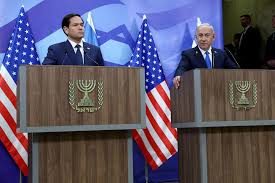On Sunday (Feb 16, 2025) Israeli Prime Minister Benjamin Netanyahu met with US Secretary of State Marco Rubio in Jerusalem to discuss their shared strategy for Gaza. Netanyahu emphasized Israel’s resolve to finish the job in Gaza by defeating Hamas.
He also expressed strong support for US President Donald Trump’s controversial proposal, which suggests removing Gaza’s two million Palestinian residents and resettling them in neighbouring countries. Netanyahu confirmed that Israel and the US are closely aligned on the plan and are working together to make it a reality.
The proposal, which has been met with strong opposition, suggests displacing Gaza’s population and having the US lead efforts to rebuild the area. Critics, including the Palestinian Authority and international bodies, have condemned the plan, arguing that it could be considered a violation of international law.
Netanyahu, however, supported the boldness of the plan, with Rubio stressing the courage required to propose an alternative to long-standing policies. “It took courage and vision to present this,” Rubio remarked, acknowledging that the idea may have surprised many but stressing that continued reliance on outdated strategies would only lead to more failure.
A major point of discussion between Netanyahu and Rubio was the shared goal of defeating Hamas, the militant group in control of Gaza. Netanyahu warned that ‘the gates of hell’ would open if all Israeli hostages, held by Hamas since the October 7, 2023, attacks, were not released. Rubio reinforced this, saying, “Hamas cannot continue as a force that governs or threatens through violence. Peace becomes impossible as long as they remain in power.”
According to reports, since the start of the war, the situation in Gaza has worsened, with more than 48,000 casualties reported by the Hamas-run health ministry. The conflict has displaced the majority of Gaza’s population, leaving many without homes, food, or access to basic services.
Leaders of the US and Israel are focused on three key goals: the release of all hostages, the destruction of Hamas, and a new future for Gaza. Netanyahu expressed hope that with US support, these goals could be achieved. “We are in a position to change the Middle East and give Israel and Gaza a future of peace and security,” he said.
On the broader regional front, Netanyahu and Rubio also discussed the threat posed by Iran, agreeing that preventing the country from acquiring nuclear weapons remains a top priority. Netanyahu praised the US for its firm support, highlighting the importance of the alliance between Israel and America in securing regional stability.
Expert Opinion: The Gaza Plan’ Uncertain Future
Md. Muddassir Quamar, Associate Professor of Middle East studies at Jawaharlal Nehru University, offered a thought-provoking perspective on Trump’s proposal for Gaza. “Trump’s promise of converting the Gaza Strip, after relocating the Palestinians to Egypt, Jordan, and other Arab countries, although outrageous, cannot be simply rejected,” he noted. According to Muddassir, the details of the plan are still unclear, and Palestinians may have little choice but to wait and see how the plan develops. He added, “Until an alternative plan is presented and accepted, this is what the Palestinians might have to endure.”
He further pointed out that the Israeli government is already enthusiastic about Trump’s proposal and has begun preparations for the relocation of Palestinians, which could echo the Nakba the displacement of Palestinians in 1948. Despite the challenges Palestinians face, Muddassir suggests that the geopolitical landscape currently favours the US and Israel, leaving the Palestinian cause at a disadvantage. “The question now is what will happen to the Palestinians and how things will pan out from here,” he said. “At this point, the only plan on the table is Trump’s and it cannot be dismissed, however unrealistic it might seem.”
